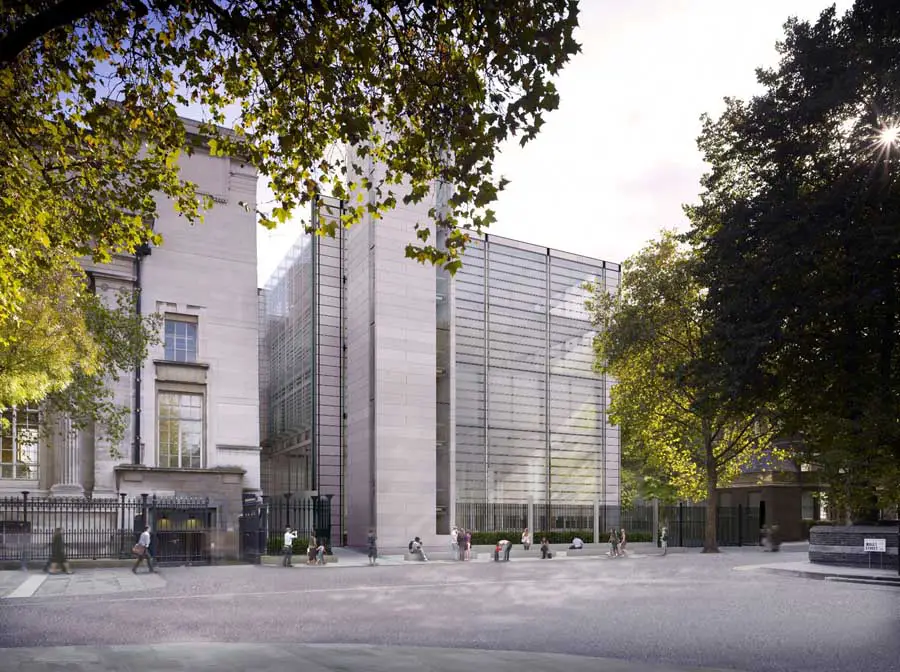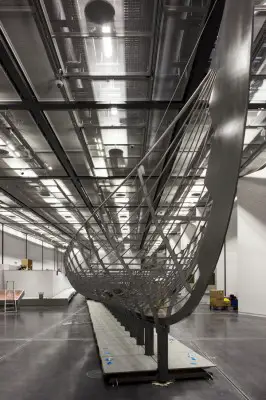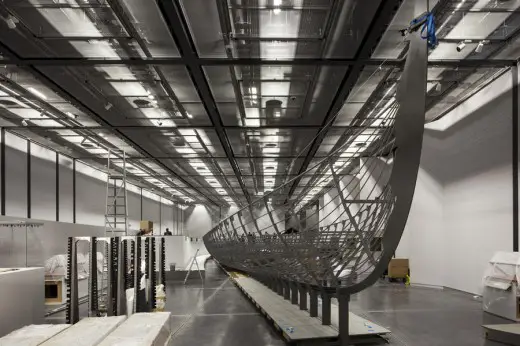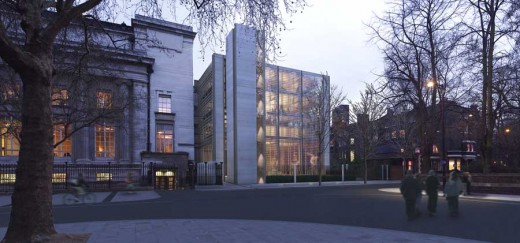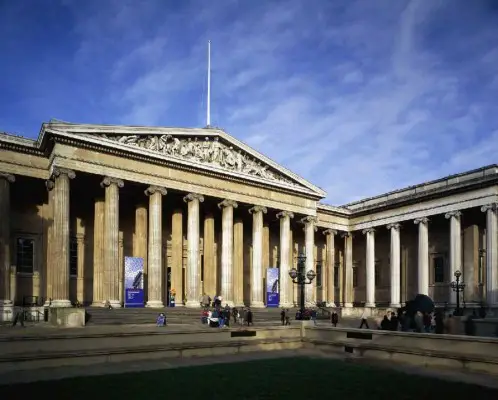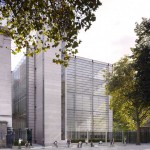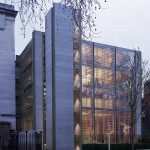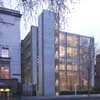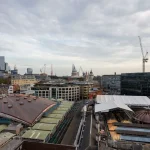British Museum Extension London building design, World Conservation and Exhibitions Centre by RSHP
British Museum Development London
BM Extension Building Development design by Rogers Stirk Harbour + Partners architects, UK
21 Jul 2017
Design: Rogers Stirk Harbour + Partners (RSHP)
Rogers Stirk Harbour + Partners’ extension to the British Museum has been shortlisted for the Stirling Prize
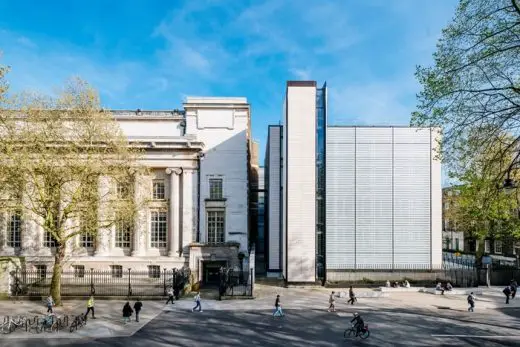
photo : Joas Souza
British Museum World Conservation and Exhibitions Centre
British Museum World Conservation and Exhibitions Centre on 2017 RIBA Stirling Prize Shortlist
This is one of six buildings on the shortlist for the 22nd annual Royal Institute of British Architects (RIBA) Stirling Prize for the UK’s best new building:
22 Jun 2017
RIBA Awards Winner in 2017
British Museum World Conservation and Exhibitions Centre is one of winners announced for the London region.
2017 RIBA National Awards for architecture
5 Apr + 7 Mar 2014
British Museum Expansion News
World Conservation and Exhibitions Centre
Design: Rogers Stirk Harbour + Partners
The British Museum’s new £135 m World Conservation and Exhibitions Centre opened to the public on 7 Mar 2014.
The new Centre will provide world class facilities for visitors and researchers taking conservation, scientific research and collection management to a new level of excellence.
Images © the Trustees of the British Museum
Key to the masterplan is the opening of the new Sainsbury Exhibitions Gallery which will host temporary exhibitions, starting with the museum’s first major exhibition on Vikings in 30 years, Vikings: Life and Legend.
The World Conservation and Exhibition Centre is located in the north-west corner of the museum’s Bloomsbury estate. It has been designed by architect Rogers Stirk Harbour and Partners: it comprises the new exhibitions gallery, laboratories, studios and storage for the collection.
One of the key exhibitis is the beautiful Roskilde 6, a ship used by the Vikings.
The installation of Roskilde 6 at the British Museum © Paul Raftery:
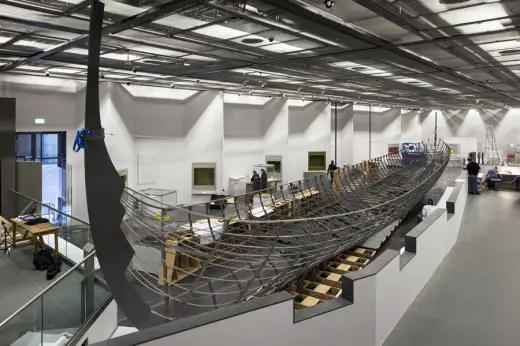
Lumsden Design has designed a shop which sits between the entrance of 1000m2 Sainsbury Exhibitions Gallery and the Egyptian Sculpture gallery.
The 188m2 space is dominated by floor-to-ceiling columns that have been integrated into the design. A monochrome palette has been applied which includes units made from black stained oak with contrasting polished white Armourcast tops which can be arranged in different formations.
12 Sep 2010
British Museum Expansion Funding
The British Museum Redevelopment Project has gained some more positive news with the announcement of a £25m ($38m) gift from John Sainsbury, the former chairman of Sainsburys (UK retailers) and Conservative peer. Previously the Sainsbury family helped fund the new wing – by Venturi, Scott Brown & Associates – at the National Gallery in London that opened in 1991.
British Museum Expansion – CABE Review
25 Nov 2009
CABE has given conditional support to the British Museum Redevelopment Project.
British Museum Development design by Rogers Stirk Harbour + Partners (RSHP):
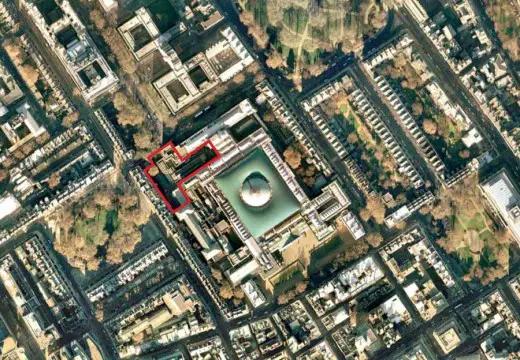
Design Review: CABE supports the design team’s intelligent response to this difficult brief and highly constrained site and the principle of inserting a contemporary extension within the envelope of the listed museum building. However, it feels that one area which could be improved is the detailed design of the proposed elevation onto Montague Place.
British Museum Development design by RSHP:
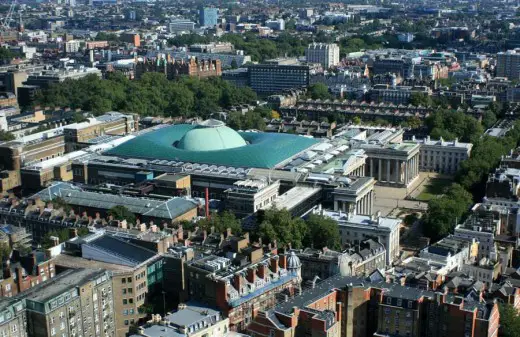
We believe that this is a successful response to the complicated physical, functional and logistical constraints of the site. The clear circulatory strategies, in both plan and section, make the resolution of a complex brief look simple. A clear and legible hierarchy has emerged from the organisation of functions and spaces in plan form and in section. We understand the constraints of the brief and support the connection from the Great Court to the proposed museum extension.
The relationship between the existing building and the extension has been well resolved; particularly the differences in levels between various parts of both building have been dealt with in a skilful manner to allow seamless circulation of people from the Great Court to the new exhibition spaces.
We support this scheme and think that it is a successful response to the complex brief but we suggest some improvements to the elevation facing onto Montague Place.
British Museum Building Extension Revision
Image Update – 24 Sep 2009
Revised view from Malet Street:
British Museum Extension : close-up of the above image
British Museum Extension Revision
News Update – 17 Sep 2009
Latest proposal includes more than a fifth of the building be buried underground, to appease opponents of the scheme. A revised planning submission is due soon. An exhibition of Rogers Stirk Harbour + Partners’ proposals starts at the British Museum on 25 Sep 2009
British Museum Extension Refusal
News Update – 24 Jul 2009
Coming hard on the heels of the Chelsea Barracks debacle this is bad news for Rogers Stirk Harbour + Partners. Camden Council planning committee unexpectedly rejected Richard Rogers’ British Museum extension project by five votes to three.
Camden Council Statement on the British Museum decision:
Camden Council’s Development Control Committee last night turned down the British Museum’s plans for the north-west development. The application was recommended for approval and had the support of English Heritage. However, after careful consideration the committee decided that the proposed benefits of the scheme did not outweigh their concerns about the design within its context. The Council will continue to respond to the concerns of the community and other interested parties looking to take this project forward.
British Museum Expansion – CABE Review
9 Jun 2009
CABE review states ‘while the stylistic approach is accomplished, we think that, in comparison, the architectural expression of the proposed extension could perhaps be stronger’ but that a ‘clear and legible hierarchy has emerged from the organisation of functions and spaces in plan form and in section.’ Previously we have received criticism of the design by Camden Civic Society.
1 Apr 2009
British Museum Extension
Design Plans for British Museum’s new development revealed
The British Museum has revealed the designs for its forthcoming development project in advance of a planning application to Camden Council in April 2009. The £135 million development has been designed by Rogers Stirk Harbour + Partners (RSHP) and will be the largest development onsite since the Great Court opened in 2000. Subject to planning permission, the new development will open in late 2012.
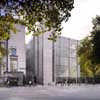
image © the Trustees of the British Museum
This project will ensure the Museum maintains its position as a leading institution for the study of human culture, in London, in Britain and the World through an upgrade of key facilities. The development will address urgent needs in terms of the Museum’s infrastructure and will provide a new exhibition space, state-of-the-art conservation and science laboratories and studios, world-class accommodation for the study collection, as well as facilities to support its extensive UK and international loan programme. It will allow the Museum to enhance the exhibition experience, to lend more of the collection and most importantly will continue to preserve the collection for future generations.
The Museum has a rich architectural heritage, the site has developed and grown at each stage of its history. This development will transform an under-utilised section of the site in the north west of the Museum, situated adjacent to the impressive King Edward VII Building which was completed in 1914.
The challenge for the architects was to produce an elegant design that expresses the contemporary role and international standing of the Museum but executed in a manner which takes its cue from the Museum’s own institutional and architectural legacy. The design incorporates five linked pavilions (with connection points to the main Museum building), covering 17,000m2 with facades in glass and stone, making a visual link to the King Edward Building. Each building will operate on seven levels, including three underground storage basements.
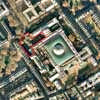
aerial photo © the Trustees of the British Museum
Prior to submitting the planning application, the Museum has been engaged in an extensive programme of consultation on the project with Camden Council, planning bodies, conservation groups and local businesses and residents. The consultation process has been very beneficial, with comments from stakeholders leading to an improved design concept for the project. English Heritage and CABE have declared their support for the development, with English Heritage commenting that the ‘proposals have the potential to provide a first-class architectural response to the aim of achieving the Museum’s objectives, set out in its masterplan’. The pre-application consultation process will continue with a public exhibition at the Museum in early April.
Funding for the project is well underway with £90 million of the total already raised. This has come from a variety of sources, including the Department of Culture, Media and Sport. The Museum is confident it can raise the remaining funds to complete the project.
The development aims to be as energy efficient as possible, the placement of the different functions has been carefully considered to minimise energy consumption. Zero carbon technologies will be incorporated into the building through the use of roof-mounted photovoltaic cells, and ground source heat transfer will also be employed in the basement walls to mitigate heat loss and provide cooling to upper floors. The electric lighting-system will automatically dim or turn off where and when there is adequate daylight to illuminate the space. The development will form part of a site-wide strategy to reduce energy consumption.
Andrew Burnett, Deputy Director of the British Museum said ‘The development will be a hugely significant project with multiple benefits for the public, the collection and for staff. It will enable the Museum to show more, lend more and preserve more of its collection for the benefit of current and future generations’
Graham Stirk, Project Director, Rogers Stirk Harbour + Partners, said: “Our proposal for the redevelopment of the north-west corner will provide a flexible series of spaces which support the wide range of activities undertaken by the British Museum. We have introduced five linked pavilions which complement the solid, formal identity of the existing Grade I listed buildings, as well as responding to the structural rhythm of the adjacent King Edward VII building. This design will be highly adaptable to the Museum’s changing requirements over time.”
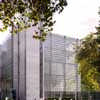
image © the Trustees of the British Museum
British Museum Expansion design : Rogers Stirk Harbour Partners
Address: Great Russell St, Bloomsbury, London WC1B 3DG, United Kingdom
Phone: +44 20 7323 8299
Architecture in London
London Architecture Links – chronological list
London Architecture Walking Tours
British Museum Great Court London
British Museum Extension Competition 2007 : Rogers Stirk Harbour & Partners win
Shortlisted architects incl. Bennetts Associates, Rick Mather Architects, Stanton Williams, Wilkinson Eyre
British Museum Building Extension
Special Exhibitions Centre
The Museum has built an enviable reputation in recent years for once in a lifetime exhibitions such as The First Emperor: China’s Terracotta Army and Hadrian: Empire and Conflict as well as smaller, thought-provoking shows highlighting contemporary middle-eastern art, Japanese crafts and American print-making.
The Museum has been able to use the Reading Room as a temporary exhibition venue to house some of these exhibitions but is in urgent need of a flexible purpose-built exhibition space to accommodate more visitors to ensure a comfortable and engaging experience. The Northwest Development includes a temporary exhibition space of over 1,000 sqm which will allow the Museum to cement its status as a leader in curating, designing and displaying special exhibitions.
Science and Conservation Laboratories
The British Museum has the largest conservation and science department in the country, covering an extensive range of materials, both ancient and modern, from the Museum’s huge and varied collection. The department is internationally recognised for its ground-breaking work, creating new knowledge and new techniques that are shared with museums thought the UK and the world.
Current facilities are in need of updating and the state-of-the-art laboratories, studios and library facilities in the development will ensure the Museum can continue to care for and research its collection. It will also allow for an expansion of the Museum’s highly regarded conservation training programme.
Logistics and Collection handling
The British Museum is committed to lending objects from the collection within the UK and across the world. The Museum lends more of its collection than any other museum or gallery, 4,000 objects to 150 institutions in 2008. A dedicated area for the preparation of loan material will ensure the safety of the thousands of objects brought into, and sent out of the Museum every year. Secure loading bays will provide direct access to the new special exhibition space, conservation and science facilities and the rest of the Museum.
Study collection storage
The world collection of the British Museum includes upwards of seven million artefacts. The majority of these objects comprise the study collection, objects which are not on permanent display for conservation reasons or because they are primarily an academic resource. On-site facilities to house the study collections will provide improved access for students, academics and the public, as well as modern, environmentally controlled systems able to maintain the stable conditions necessary for the preservation of objects.
RSHP’s proposal seeks to:
– create a distinctive set of buildings that complement the architectural styles of the surrounding area and establishes a dialogue between the contemporary and historic architecture of Bloomsbury.
– ensure that the new buildings are distanced from the Grade I listed façades with minimal interventions in the existing fabric, while creating a solid visual aesthetic that complements the King Edward VII Building
– apply an order to the otherwise disparate nature of this area of the site and surrounding context. The five linked pavilions – each of five storeys – are consistent in height with the North Range and one storey lower than the King Edward VII building.
The mass and height of the pavilions provide a transition from the institutional scale of the King Edward VII building to the domestic scale of the properties in Bedford Square and Gower Street
The functional requirements of the brief are arranged vertically. The Collections Storage Facility has been located below ground where the heavy floor loading can easily be accommodated and where the most stable environmental conditions can be found. Above this sits the new logistic hub on Level 0, linking easily into the logistic routes of the existing museum.
The Special Exhibitions Gallery has been located at Level 2 (main gallery level in the Museum) in order to allow the best connectivity for the public and to enhance visitor experience. The conservation and science laboratories sit above the gallery in order to provide good quality daylight for conservation work as well as placing the requirement for flues, fume extraction and ventilation at the top of the building.
Key London design by Richard Rogers : Lloyd’s Building
Comments / photos for the British Museum Development London Architecture page welcome

